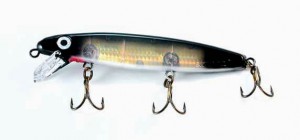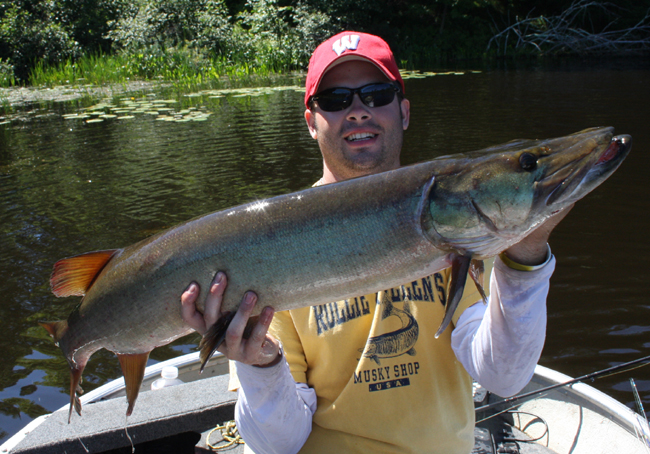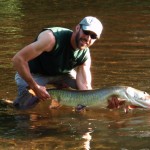If you’re muskie fishing during spring and early summer, a standby piece of advice you’ve probably heard repeatedly and absorbed is that it’s necessary to downsize your baits in order to catch fish. During this season, as water temperatures remain cool and most common forage species are small in size, matching the hatch and fishing with smaller baits is most compatible with the early season feeding habits of muskies. Whatever the justification, downsizing by default is a common, wildly successful practice that is followed by many early season muskie anglers.
While downsizing during the spring works wonders on fish, several anglers eventually pack their snack sized lures away in favor of oversized plugs and bucktails as soon as water temperatures warm, and summer fishing patterns emerge. While this is how many of us catch our fish as the fishing season progresses, it’s not entirely necessary.
My fellow muskie anglers, you don’t want to make the mistake of completely putting away your downsized lures in favor of the larger hardware, plastic, and wood. The smaller baits used in spring and early summer will consistently catch muskies year round and, in some cases, have the capabilities of catching more fish than everything else.

Why Downsize?
From the season opener till closing time late in the year, I have found that many times a downsized presentation can make the difference between a futile outing and a successful outing. In many situations, downsizing can be the only thing that will catch fish. Regardless of weather, conditions, water temperatures, time of season, feeding habits and more, this is a practice that puts more fish in the boat for me than anything else. It has also produced many of my most memorable multi-fish days.
I recall several outings throughout the 2011 fishing season that were otherwise poor with weather and not ideal for successful fishing in anyone’s book. One of these notable outings took place during the dog days of summer. This particular event made me acknowledge the power of small lures.
It was a mid-August mid-afternoon on a dark water river system in Sawyer County, Wisconsin. My friend and I fished and floated the river on one of the worst, most non-ideal days for muskies I could ever imagine. Air temperatures were near 80 degrees, bright sun without a cloud in the sky, and no wind. Water temperatures were a bit on the high side at 72 degrees, but otherwise normal for middle of the day in summer.
After three hours and several hundred casts of not seeing a single fish with any larger profile lures, I pulled out my largest, heaviest bass flipping stick; a seven and a half foot Quantum Tour Edition rod with a 2 ounce rating paired with a Quantum Energy SS casting reel. For modern muskie standards, this would be light action, but sufficient enough for most downsized applications and able to handle all fish. Out of frustration I clipped on a hand-size 1 ounce chartreuse green double bladed flashabou spinner with fluorescent orange number 6 blades my friend Dan Sims assembled for me. This lure in particular is the easiest lure to cast and speed reel that I own.
On the fifth cast to the shaded, wood-infested extreme shallows, a fish struck as soon as it landed. Following a brief fight, came into the Frabill one of the largest fish I’d end up seeing all year long; A 42 incher. Within 30 minutes, I caught another. And throughout the remainder of this unglamorous doggone day of summer, I’d end up seeing several more.
At the time of this event, the small flashabou spinner I used was only a prototype. Since then, and several fish later, it’s now in full production as a downsized muskie offering from Sims Spinners.

Downsizing Situations
Although I rely on small lures throughout much of the year, certain conditions require their use. Foremost are places with high fishing pressure. If I’m fishing a lake or river that sees a considerable amount of anglers on a daily basis, I often scale down because these folks putting pressure on fish are the ones frequently using large, over-size lures that most fish are likely uninterested in. I encounter this often on the more popular lakes I fish. When small baits are on their game, I have fun cleaning up on leftovers and the fish most people miss out on.
Next, small baits shine as performers in shallow water, especially during bright conditions as they land in the water with minimal impact. This was the case during my mid-August river trip as previously mentioned. When fan casting and fishing in tight quarters, trying to catch fish and not spook them as they are in the shallows, dead accurate casting with smaller bucktails and blades and ripping them back to boatside can’t be beat.
It is well known, and thoroughly noted that downsizing is a must during cold fronts when fish are tight lipped. However, downsizing is a tactic that should be equally utilized during warm, high pressure days featuring bright sun and very little wind. These conditions are most prevalent during mid to late summer as water temperatures hit their peak and most lakes stratify. At these times, most anglers would likely search deep for suspending fish that are utilizing the thermocline as a cool water sanctuary. However, by thinking outside of the box, you wouldn’t believe the high activity levels I encounter from muskies remaining in shallower water. Burning blades, walking topwaters, and ripping shallow minnowbaits will trigger bites.

Small Bites to Catch Muskies
I’ll be honest with you, I’ve never caught a musky on any giant plug or bucktail. In fact (besides live suckers), I don’t think I’ve ever caught a muskie on anything larger than 10-inches in my life! Since I began musky fishing more than five years ago, my fishing has evolved and been developed by throwing small lures. This is a program I still religiously follow. Preferably, I like throwing lures that are not even half as large as the ones most anglers frequently throw.
Muskie fishing is a weird pursuit and most of the baits and lures designed for these fish are downright weird and silly looking. Let’s not forget they work. But with all weirdness aside, in my opinion, the weirdest thing to me about muskie fishing are the anglers who never turn to small baits, and how they are widely perceived as lures for little fish.
I fail to comprehend why so few anglers choose to throw small lures. When 4 and 5-inch baits are the discussion, most muskie anglers won’t even acknowledge them, or ever consider using them.
While muskie anglers cast large baits like robots, and retrieve them mechanically without many variations, large lures have a very limited range of retrieve options in comparison to downsized versions. In contrast, smaller lures open an entire world of diverse muskie presentations and are more fun for me to fish with.
Downsized lures such as the Mepps Musky Killer, Blue Fox Musky Buck, Sims Double 6 and 7 Flashabous, Buchertail Shallow Raider, 6 inch ERC Jake, Rapala Glidin’ Rap 12, and Rapala X-Rap Walk are fun and comfortable to cast and retrieve. In addition, they are versatile in movement to be retrieved in many different methods.




Advantage Agreements
Fishing with downsized lures has its advantages. The biggest of them is that they’re easy to fish with for all day use unlike more popular, new age large musky baits such as Pounder Bulldawgs and double bladed Cowgirls with whopping size 10 blades. Most anglers don’t have the strength or patience to throw these whopper muscle-toning lures with oversize rods and reels, and neither do I. Unlike these large baits, downsized lures won’t wear you down as much. In addition, they’re easier to manipulate and perform various retrieve and figure-8 maneuvers.
Unlike large lures, small lures readily respond to imparted action of the rod tip and any retrieve manipulations. With most of the downsized lures I use on my lighter casting set-ups, I can precisely control everything from speed to pauses, jerks and movements towards any direction, retrieve angles, and figure 8 motions.
Besides ease of use, another advantage of downsized lures is seen in hookup rates. I cannot tell you how many large fish I lost in 2011 due to poor hook penetration with large lures. In comparison to the dozen of failed hook-ups with large lures, I logged two fish that were lost all year with small lures; a huge difference. When I patiently walk the X-Rap Walk along the surface, or burn the small Sims double flashabou, missed fish for me are pretty rare. With smaller lures like these, the smaller size and profile of the lure will not deflect fish away from their sharp hooks with the same propensity as large lures do.

Whether fishing lakes or floating on rivers, there have been several instances in which I’ve raised uninterested fish to boatside, but couldn’t get them to commit to striking. Furthermore, I have had more instances in which fish couldn’t be encountered for several hour periods along with several hundred casts more. Moments like these make me realize that musky fishing isn’t always about throwing the large typical lures that fish may not eat. My philosophy is that for every follower or unseen fish, there is always a way to make the fish bite and to then catch it. Downsizing ultimately allows me to do this and a lot more. When it comes to locating and responding to the behavior of muskies, small lures will offer the angler a bigger bag of tricks with a greater window of opportunities, and increase his or her chances of catching.







